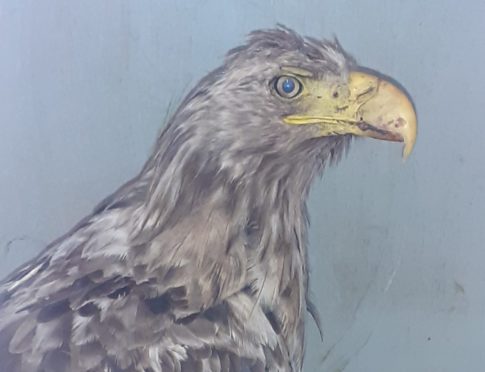
An animal welfare charity rescued a rare sea eagle found with a head injury near a wind farm on moorland in Lewis.
The Scottish SPCA was alerted to the injured bird on August 10 and found it being swarmed by midges.
Scottish SPCA auxiliary inspector, Maggie Adkins, said: “On arrival it was clear the eagle had a serious head injury and it was also being eaten alive by midges.
“It was found in a remote part of the island close to a large wind turbine, so this is likely to have been the cause of its injuries.”
She took the bird to a vet where x-rays revealed nothing broken, but severe bruising to the body as well as head trauma.
As the eagle has an RSPB leg ring, she also contacted Robin Reid, senior conversation officer for the RSPB in the Western Isles, who confirmed it had been born in 2009 in Lewis.
The bird is now recovering from its injuries and it’s hoped it will soon be released back into the wild.
There are about 30 pairs of sea eagles, or white-tailed eagles, in Lewis, which has around 20% of the Scottish population.
Mr Reid said it has not been confirmed that the sea eagle collided with a turbine.
“We have not drawn any conclusions that is a definite turbine casualty but it is concerning that we are finding a sea eagle with serious head injuries in a place close to turbines,” he said.
“There are not a lot of other things that could cause that.”
He added: “The population of white-tailed eagles on the Isle of Lewis has been increasing in recent years, following their successful re-introduction to Scotland.
“We know the species is susceptible to collisions with wind turbines and we are concerned about the impact of further proposed wind farms in the area.”
Anti wind farm campaigner Lyndsey Ward said it is possible the bird could have struck a turbine.
“With inadequate small search zones and no 24/7 monitoring of turbines, we have no reliable data regarding the severity of this problem,” she said.
Stephanie Conesa, policy manager at Scottish Renewables, said: “Wind farm developers spend years collecting detailed data on bird populations, which is then scrutinised by nature conservation bodies as part of planning applications.
“These assessments are then put before government advisors and planning authorities to ensure the work is scientifically robust and meets all required national and international environmental legislation.”
She said the industry was working closely with the Scottish Government, Scottish Natural Heritage, RSPB and others to better understand bird behaviour and make sure that wind developments are sensitive to bird populations.
And she added: “Wind energy is one of the key technologies we are able to deploy at scale to reduce the carbon emissions which cause climate change – the greatest long-term threat to Scotland’s wildlife.”